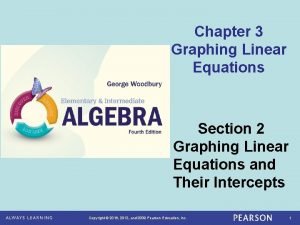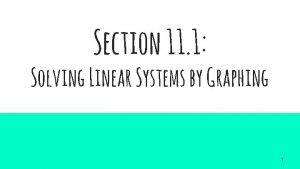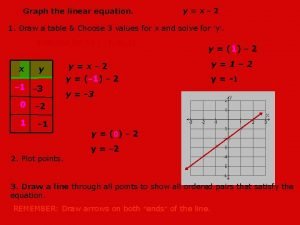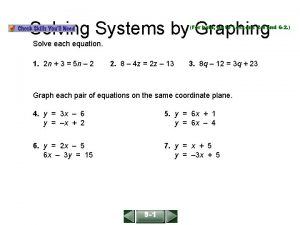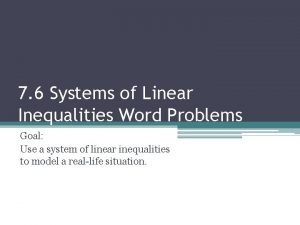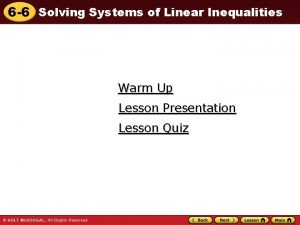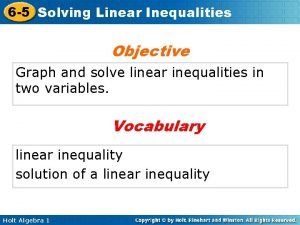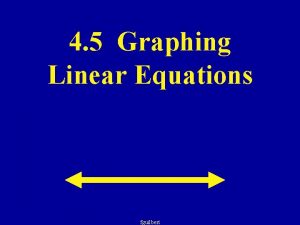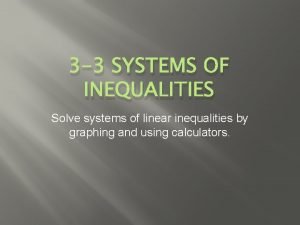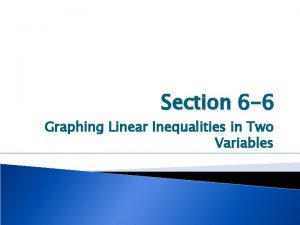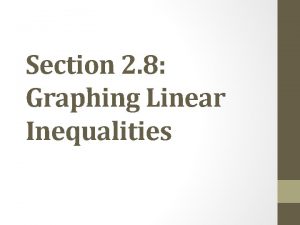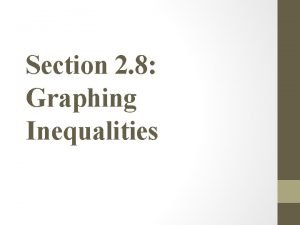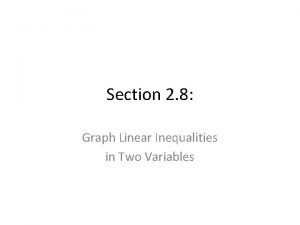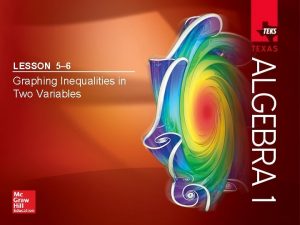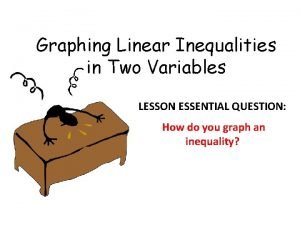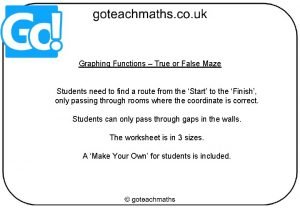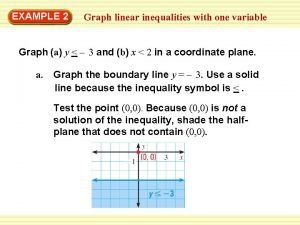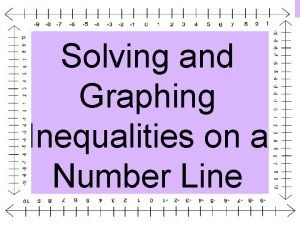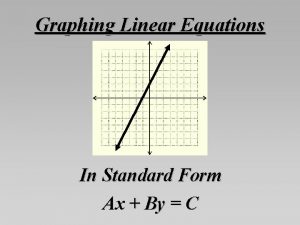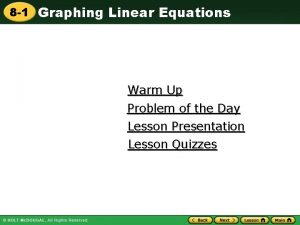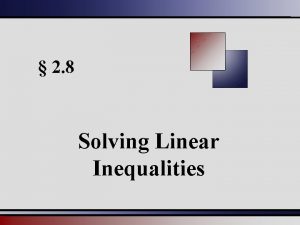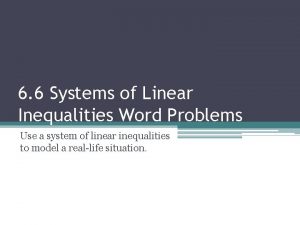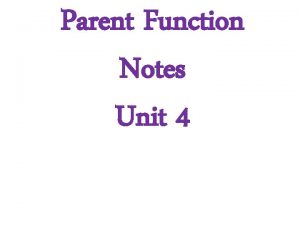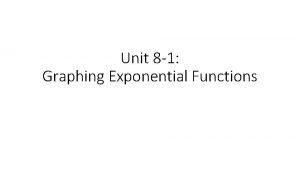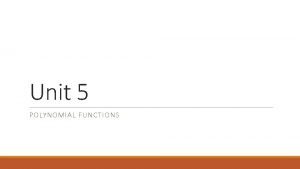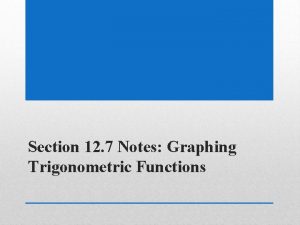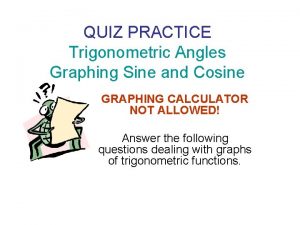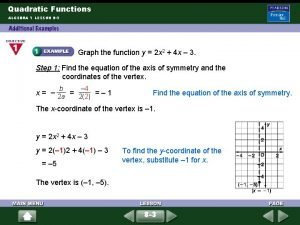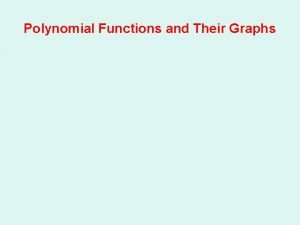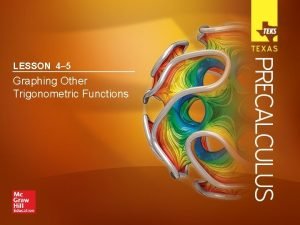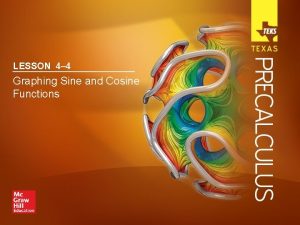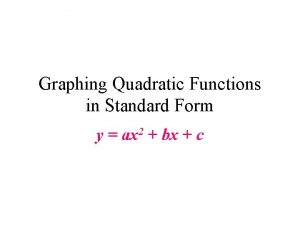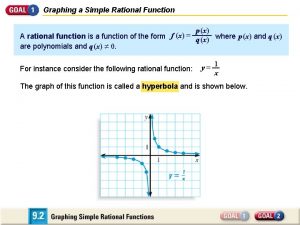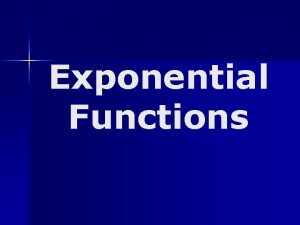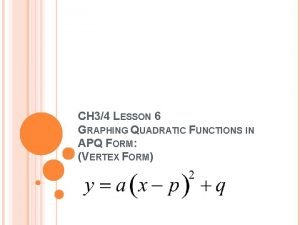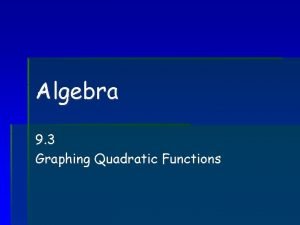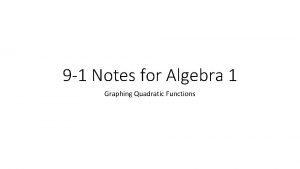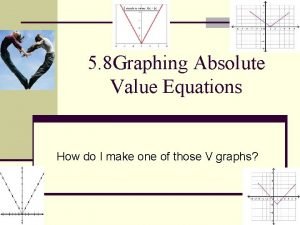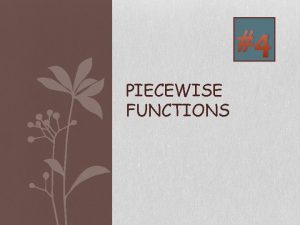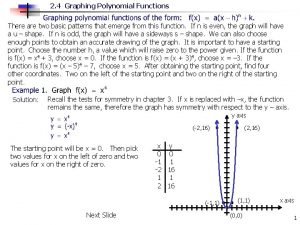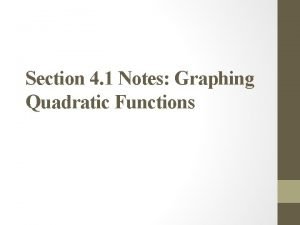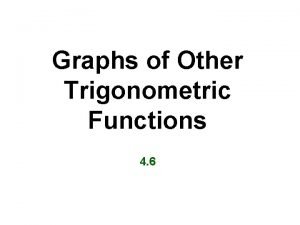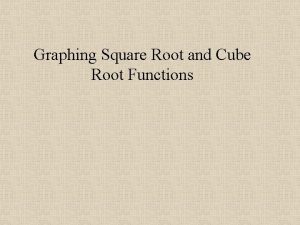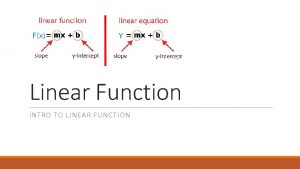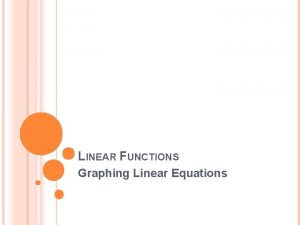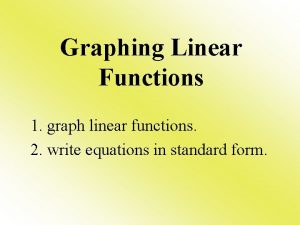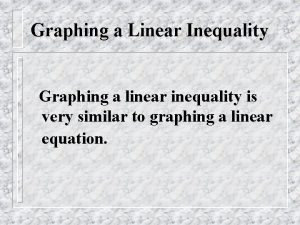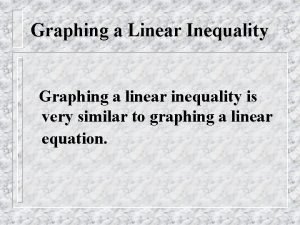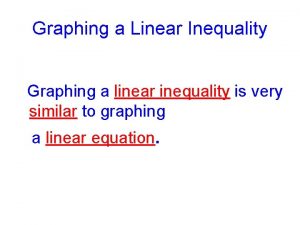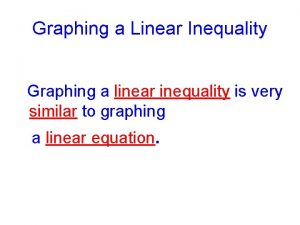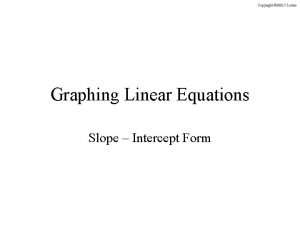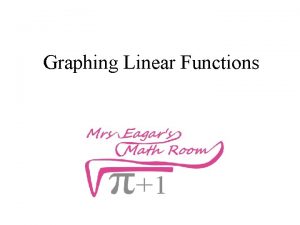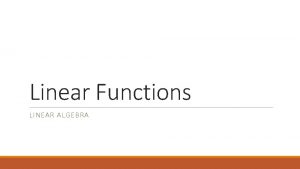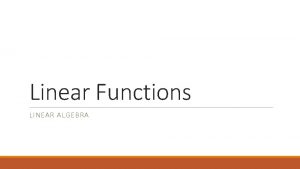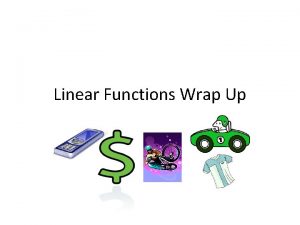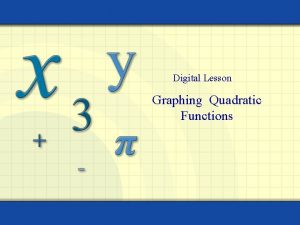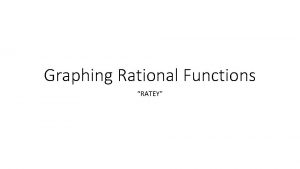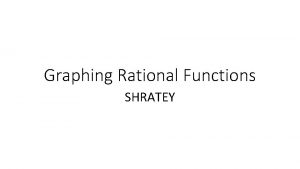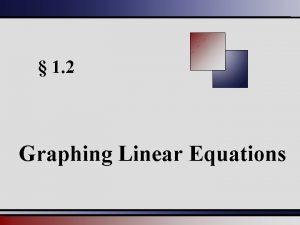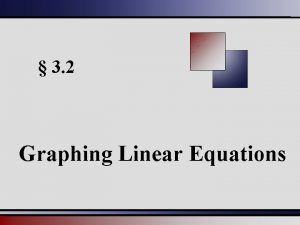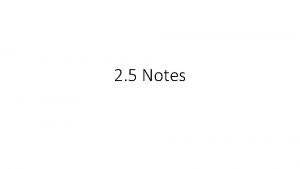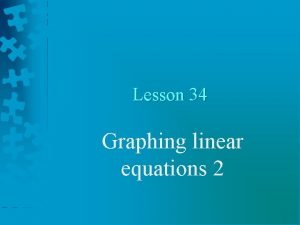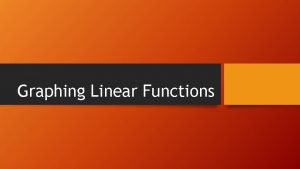GRAPHING LINEAR FUNCTIONS CHAPTER 3 3 1 FUNCTION
















































- Slides: 48

GRAPHING LINEAR FUNCTIONS CHAPTER 3

3. 1 FUNCTION What you will learn: § Determine whether relations are functions § Find the domain and range of a functions § Identify the independent and dependent variable functions

ESSENTIAL QUESTION What is a function?

PREVIOUS VOCABULARY Ordered Pair Mapping Diagram

CORE VOCABULARY Relation Function Domain Range Independent Variable Dependent Variable

RELATION Pairs inputs with outputs When given as an ordered pairs, the xcoordinates are inputs and the y-coordinates are outputs

FUNCTION A relation that pairs each input with exactly one output

DOMAIN The set of all possible input values

RANGE The set of all possible output values

INDEPENDENT VARIABLE The variable that represents the input values of a function It can be any value in the domain

CORE CONCEPT VERTICAL LINE TEST § A graph is a function when no vertical line passes through more than one point on the graph

3. 2 LINEAR FUNCTIONS What you will learn: § Identify linear functions using graphs, tables, and equations § Graph linear functions using discrete and continuous data § Write real-life problems to fit data

ESSENTIAL QUESTION: How can you determine whether a function is linear or nonlinear? LEAVE 4 LINES

CORE VOCABULARY linear equation in discrete domain two variables continuous linear function domain nonlinear function solution of a linear equation in two variables

LINEAR EQUATION IN TWO VARIABLES an equation that can be written in the form y = mx + b m and b are constants Graph is a line

LINEAR FUNCTION function whose graph is a nonvertical line has a constant rate of change can be represented by a linear equation in two variables

NONLINEAR FUNCTION does not have a constant rate of change its graph is not a line.

SOLUTION OF A LINEAR EQUATON IN TWO VARIABLES an ordered pair (x, y) that makes the equation true The graph is the set of points (x, y) in a coordinate plane that represents all solutions of the equation

DISCRETE DOMAIN set of input values that consists of only certain numbers in an interval

FUNCTION NOTATION set of input values that consists of all numbers in an interval

3. 3 FUNCTION NOTATION What you will learn: § Function notation to evaluate and interpret functions § Use function notation to solve and graph functions § Solve real-life problems using function notation

ESSENTIAL QUESTION: How can you use function notation to represent a function? LEAVE 4 LINES

PREVIOUS VOCABULARY Linear function Quadrant

CORE VOCABULARY Function notation

FUNCTION NOTATION f(x) another name for y read as “the value of f at x” read as “f of x. ” g, h, j, and k are also used

CORE CONCEPT Multiplication and Division Properties of Inequality §When multiplying or dividing each side of an inequality by the same negative number, the direction of the inequality symbol must be reversed to produce an equivalent inequality.

3. 4 GRAPHING LINEAR EQUATIONS IN STANDARD FORM What you will learn: § Graph equations of horizontal and vertical lines § Graph linear equations in standard form using intercepts § Use linear equations in standard form to solve real-life problems

ESSENTIAL QUESTION: How can you describe the graph of the equation Ax + By = C? LEAVE 4 LINES

PREVIOUS VOCABULARY Ordered Pair Quadrant

CORE VOCABULARY Standard form x-intercept y-intercept

STANDARD FORM Ax + By = C A, B, and C are numbers A and B do not equal 0

X-INTERCEPT Where the graph crosses the x-axis Y=0 (x, 0)

Y-INTERCEPT Where the graph crosses the y-axis x=0 (0, y)

CORE CONCEPT Horizontal Lines §Goes from left to right §Crosses the y-axis §y = a number §No slope

CORE CONCEPT Vertical Lines §Goes up and down §Crosses the x-axis §x = a number §Slope is undefined

2. 5 SOLVING COMPOUND INEQUALITIES What you will learn: §Write and graph compound inequalities §Solve compound inequalities §Use compound inequalities to solve real life problems

ESSENTIAL QUESTION How can you use inequalities to describe intervals on the real number line?

VOCABULARY Compound inequalities

COMPOUND INEQUALITIES Formed by joining two inequalities with the word “and” or “or”

CORE CONCEPT Compound inequalities “and” § “and” is the intersection of the inequalities § “and” contains the solutions that are the same in both inequalities

CORE CONCEPT Graphing Compound inequalities “or” § “or” is the union of the inequality’s solutions § “or” contains all the solutions for both inequalities

2. 6 ABSOLUTE VALUE EQUATIONS What you will learn:

ESSENTIAL QUESTION: How can you solve an absolute value equation?

PREVIOUS VOCABULARY Compound inequality (2. 5) Mean (1. 2)

CORE VOCABULARY Absolute value inequality Absolute deviation

ABSOLUTE VALUE INEQUALITY An inequality that contains and absolute value expression

ABSOLUTE DEVIATION Absolute value of the difference of x and the given number

 Chapter 3 graphing linear functions answer key
Chapter 3 graphing linear functions answer key Graphing linear and exponential functions
Graphing linear and exponential functions Bounded or unbounded graph
Bounded or unbounded graph Lesson 11-1 solving linear systems by graphing answer key
Lesson 11-1 solving linear systems by graphing answer key Solve y
Solve y 1/x graph
1/x graph Lesson 9-1 slope
Lesson 9-1 slope System of linear inequalities word problems
System of linear inequalities word problems Solving linear inequalities quiz
Solving linear inequalities quiz Inequality in two variables
Inequality in two variables 4-5 graphing linear equations
4-5 graphing linear equations Solve systems of linear inequalities by graphing calculator
Solve systems of linear inequalities by graphing calculator Graphing inequalities
Graphing inequalities 2-8 graphing linear inequalities
2-8 graphing linear inequalities 2-8 graphing linear and absolute value inequalities
2-8 graphing linear and absolute value inequalities 2-8 graphing linear inequalities
2-8 graphing linear inequalities Graphing linear equations definition
Graphing linear equations definition Lesson 5 - graphing linear equations and inequalities
Lesson 5 - graphing linear equations and inequalities Steps in graphing linear inequalities in two variables
Steps in graphing linear inequalities in two variables Graphing linear inequalities maze
Graphing linear inequalities maze Solving linear inequalities in one variable
Solving linear inequalities in one variable Dot symbol
Dot symbol Graphing solutions on a number line
Graphing solutions on a number line Ax + by=c
Ax + by=c Graphing linear equations vocabulary
Graphing linear equations vocabulary Graphing linear inequalities
Graphing linear inequalities Systems of inequalities word problems
Systems of inequalities word problems Linear vs nonlinear table
Linear vs nonlinear table Parent functions notes
Parent functions notes All real numbers on graph
All real numbers on graph Unit 5 homework 4 factoring polynomials
Unit 5 homework 4 factoring polynomials 12-7 graphing trigonometric functions answers
12-7 graphing trigonometric functions answers Graphing sine and cosine functions quiz
Graphing sine and cosine functions quiz Lesson 8-1 transformations of functions
Lesson 8-1 transformations of functions Graphing polynomial functions
Graphing polynomial functions 4-5 practice graphing other trigonometric functions
4-5 practice graphing other trigonometric functions 4-4 graphing sine and cosine functions worksheet answers
4-4 graphing sine and cosine functions worksheet answers Standard form y=ax^2+bx+c
Standard form y=ax^2+bx+c Rational function graph in real life
Rational function graph in real life What is rigid and non rigid
What is rigid and non rigid 9-1 practice graphing quadratic functions
9-1 practice graphing quadratic functions 9-3 practice solving quadratic equations by graphing
9-3 practice solving quadratic equations by graphing Algebra 1 notes
Algebra 1 notes 5-8 practice graphing absolute value functions
5-8 practice graphing absolute value functions Example of piecewise function problem
Example of piecewise function problem Graphing polynomial functions
Graphing polynomial functions 4-1 graphing quadratic functions
4-1 graphing quadratic functions Graphing other trig functions
Graphing other trig functions Cube root function graph
Cube root function graph
